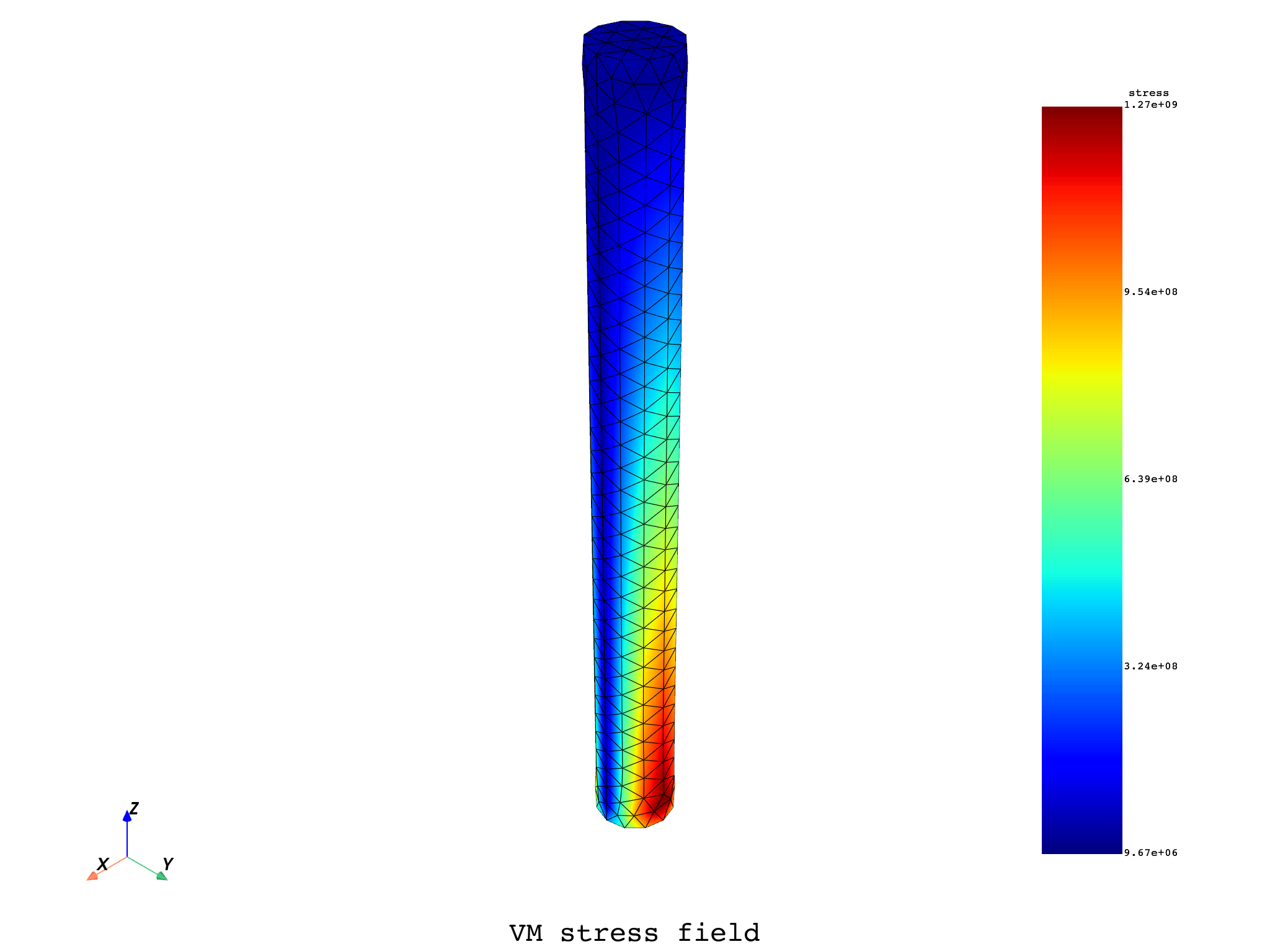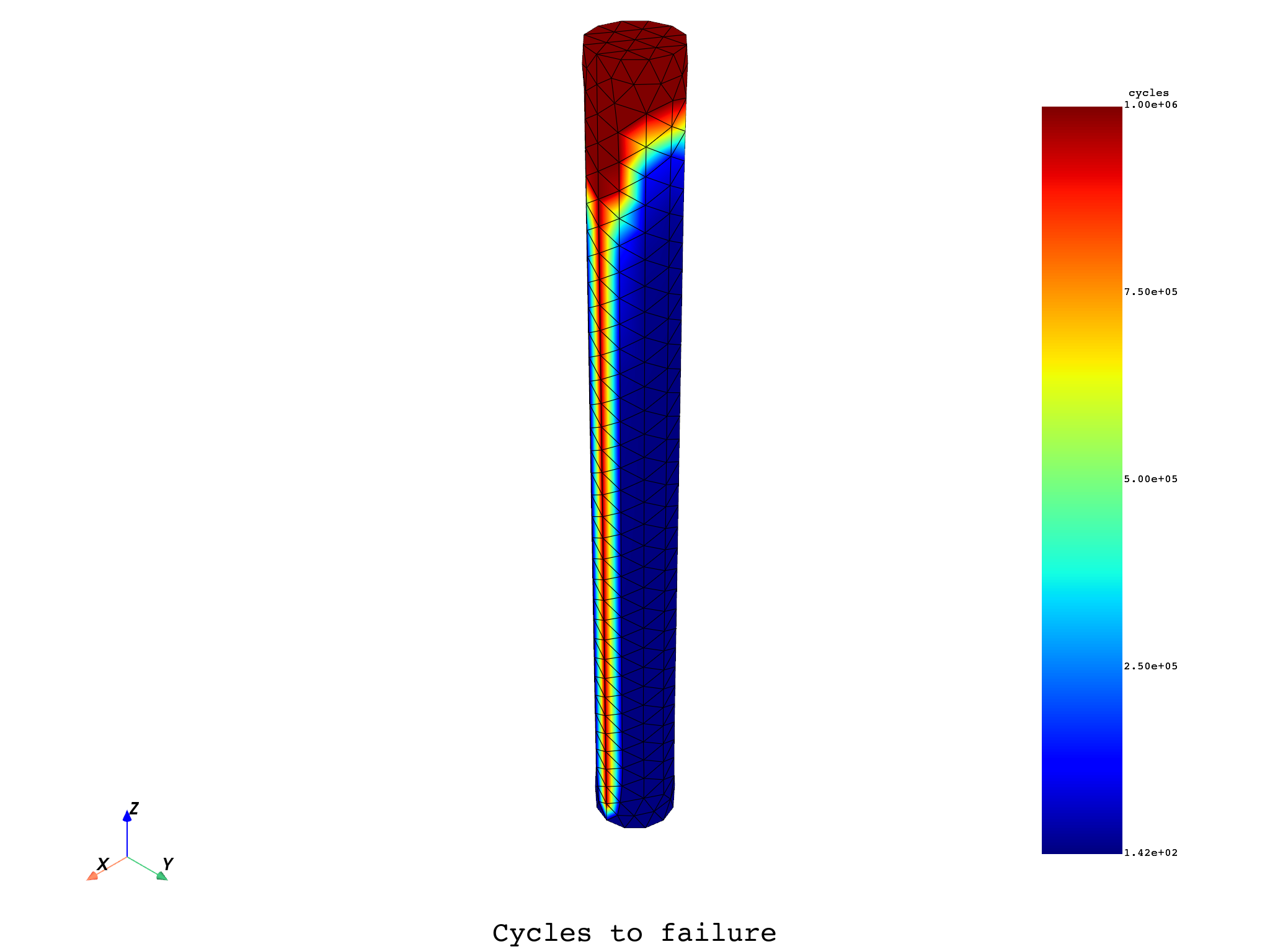Note
Go to the end to download the full example code.
Calculate the number of cycles to fatigue failure#
This example shows how to generate and use a result file to calculate the cycles to failure result for a simple model.
Material data is manually imported, Structural Steel from Ansys Mechanical:
Youngs Modulus (youngsSteel)
Poisson’s Ratio (prxySteel)
SN curve (sn_data)
The first step is to generate a simple model with high stress and save the results .rst file locally to myDir (default is “C:\temp”). For this, we provide a short pyMAPDL script.
The cycles to failure result is the (interpolated) negative of the stress result. The higher the stress result, the lower the number of cycles to failure.
import numpy as np
from ansys.dpf import core as dpf
from ansys.dpf.core import examples
The first step is to generate a simple model with high stress
# # Material parameters from Ansys Mechanical Structural Steel
youngsSteel = 200e9
prxySteel = 0.3
sn_data = np.empty((11, 2)) # initialize empty np matrix
sn_data[:, 0] = [10, 20, 50, 100, 200, 2000, 10000, 20000, 1e5, 2e5, 1e6]
sn_data[:, 1] = [
3.999e9,
2.8327e9,
1.896e9,
1.413e9,
1.069e9,
4.41e8,
2.62e8,
2.14e8,
1.38e8,
1.14e8,
8.62e7,
]
The .rst file used is already available, but can be obtained using the short pyMAPDL code below:
# # ### Launch pymapdl to generate rst file in myDir
# from ansys.mapdl.core import launch_mapdl
# import os
#
#
# mapdl = launch_mapdl()
# mapdl.prep7()
# # Model
# mapdl.cylind(0.5, 0, 10, 0)
# mapdl.mp("EX", 1, youngsSteel)
# mapdl.mp("PRXY", 1, prxySteel)
# mapdl.mshape(key=1, dimension='3d')
# mapdl.et(1, "SOLID186")
# mapdl.esize(0.3)
# mapdl.vmesh('ALL')
#
# # #### Boundary Conditions: fixed constraint
# mapdl.nsel(type_='S', item='LOC', comp='Z', vmin=0)
# mapdl.d("all", "all")
# mapdl.nsel(type_='S', item='LOC', comp='Z', vmin=10)
# nnodes = mapdl.get("NumNodes", "NODE", 0, "COUNT")
# mapdl.f(node="ALL", lab="fy", value=-13e6 / nnodes)
# mapdl.allsel()
#
# # #### Solve
# mapdl.run("/SOLU")
# sol_output = mapdl.solve()
# rst = os.path.join(mapdl.directory, 'file.rst')
# mapdl.exit()
# print('apdl model solved.')
PyDPF-Core is then used to post-process the .rst file to estimate the cycles to failure.
# Comment the following line if solving the MAPDL problem first.
rst = examples.download_cycles_to_failure()
# Import the result as a DPF Model object.
model = dpf.Model(rst)
print(model)
DPF Model
------------------------------
Static analysis
Unit system: Undefined
Physics Type: Mechanical
Available results:
- displacement: Nodal Displacement
- reaction_force: Nodal Force
- smisc: Elemental Elemental Summable Miscellaneous Data
- element_nodal_forces: ElementalNodal Element nodal Forces
- stress: ElementalNodal Stress
- elemental_volume: Elemental Volume
- stiffness_matrix_energy: Elemental Energy-stiffness matrix
- artificial_hourglass_energy: Elemental Hourglass Energy
- thermal_dissipation_energy: Elemental thermal dissipation energy
- kinetic_energy: Elemental Kinetic Energy
- co_energy: Elemental co-energy
- incremental_energy: Elemental incremental energy
- elastic_strain: ElementalNodal Strain
- thermal_strain: ElementalNodal Thermal Strains
- thermal_strains_eqv: ElementalNodal Thermal Strains eqv
- swelling_strains: ElementalNodal Swelling Strains
- element_orientations: ElementalNodal Element Euler Angles
- structural_temperature: ElementalNodal Structural temperature
------------------------------
DPF Meshed Region:
4102 nodes
2356 elements
Unit:
With solid (3D) elements
------------------------------
DPF Time/Freq Support:
Number of sets: 1
Cumulative Time (s) LoadStep Substep
1 1.000000 1 1
Get the von mises equivalent stress, requires an operator.
s_eqv_op = dpf.operators.result.stress_von_mises(data_sources=model)
vm_stress_fc = s_eqv_op.eval()
vm_stress_field = vm_stress_fc[0]
vm_stress_field.plot(text="VM stress field")

(None, <pyvista.plotting.plotter.Plotter object at 0x000001DD9F1648D0>)
Use NumPy to interpolate the results.
# Inverse the sn_data
x_values = sn_data[:, 1][::-1] # the x values are the stress ranges in ascending order
y_values = sn_data[:, 0][::-1] # y values are inverted cycles to failure
# Interpolate cycles to failure for the VM values
cycles_to_failure = np.interp(vm_stress_field.data, x_values, y_values)
Generate a cycles_to_failure DPF Field
# Create an empty field
cycles_to_failure_field = dpf.Field(
nentities=len(vm_stress_field.scoping),
nature=dpf.natures.scalar,
location=dpf.locations.nodal,
)
# Populate the field
cycles_to_failure_field.scoping = vm_stress_field.scoping
cycles_to_failure_field.meshed_region = vm_stress_field.meshed_region
cycles_to_failure_field.data = cycles_to_failure
# Plot the field
sargs = dict(title="cycles", fmt="%.2e")
cycles_to_failure_field.plot(text="Cycles to failure", scalar_bar_args=sargs)

(None, <pyvista.plotting.plotter.Plotter object at 0x000001DD9DC93190>)
Total running time of the script: (0 minutes 5.193 seconds)

